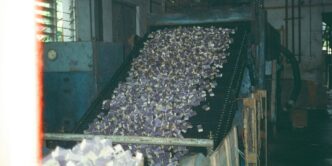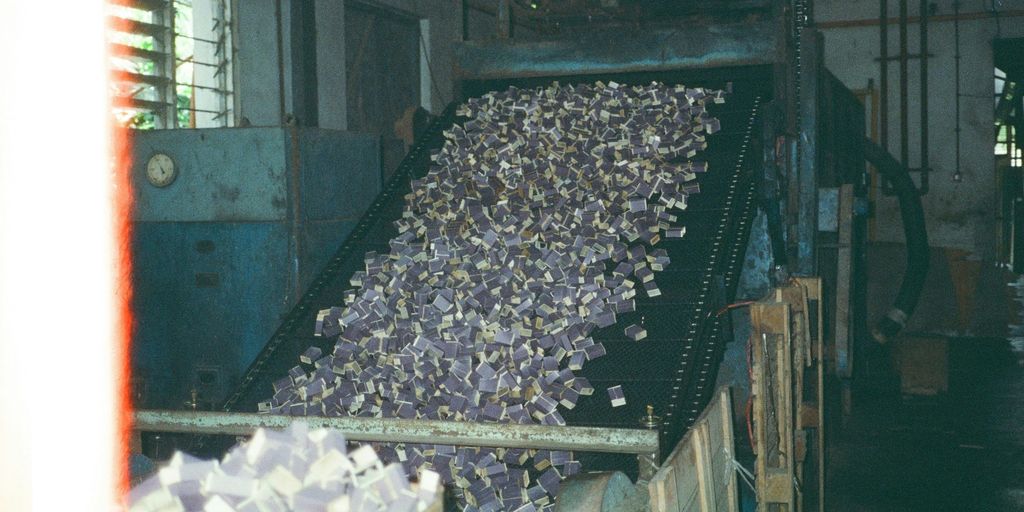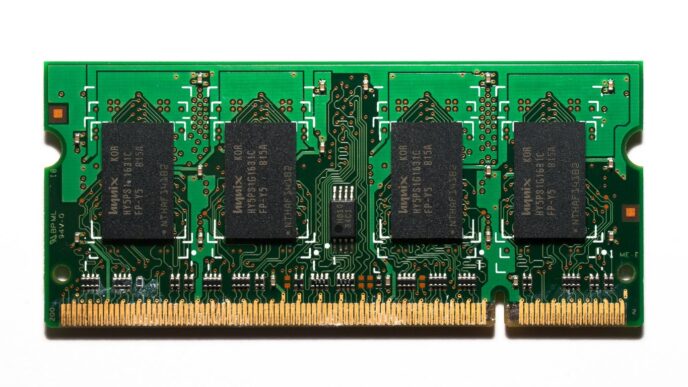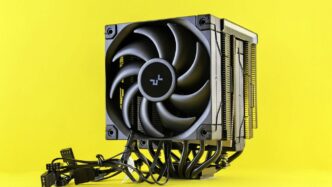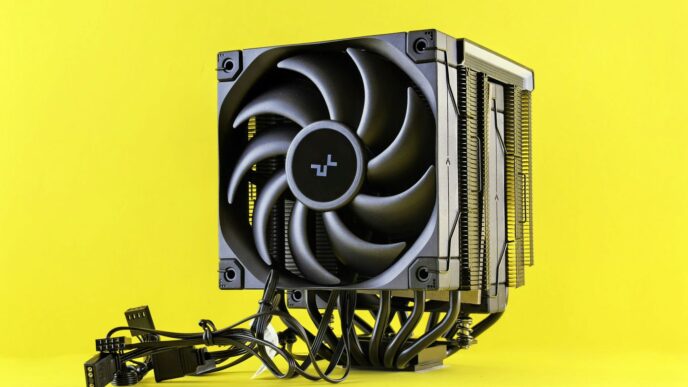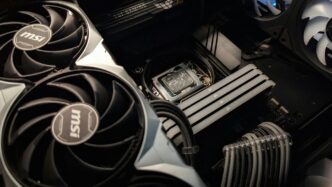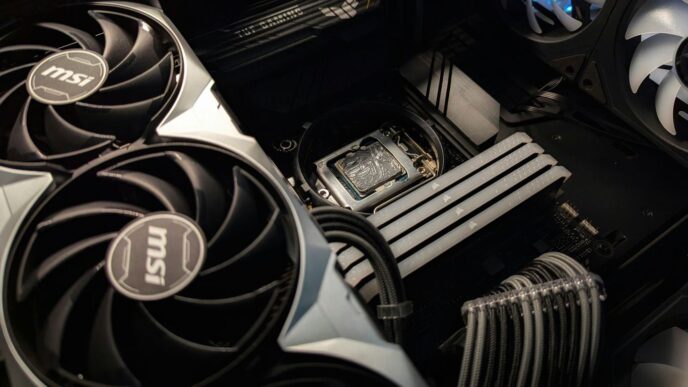Ever wonder where the brains of your iPhone or Mac come from? You know, the actual chips that make everything run? It’s a pretty interesting story, and it’s not as simple as just one place. Apple has really changed how they do things over the years, moving from using other companies’ parts to making a lot of their own stuff. This shift has made them pretty unique in the tech world. So, if you’ve ever asked yourself, “where are apple chips made?” you’re in the right spot to find out.
Key Takeaways
- Apple designs its own chips, which is a big change from how they used to do things. They have a lot of engineers working on this.
- While Apple designs their chips in places all over the world, the actual making of the most advanced chips mostly happens in Taiwan.
- Apple started making its own chips for iPhones back in 2010 and now even their Mac computers use them.
- They bought a company called P.A. Semi a while back, and that really helped them get started on making their own chips.
- Apple isn’t selling their chips to other companies; they just make them for their own products.
Apple’s In-House Chip Design
Apple’s move to design its own chips has been a game-changer. It’s not just about having custom silicon; it’s about controlling the entire experience. For years, Apple relied on external chip manufacturers, but now they’re calling the shots. This shift allows them to optimize performance in ways that weren’t possible before.
The Shift to Custom Silicon
Apple’s decision to bring chip design in-house was a strategic move to gain greater control over its products’ performance and differentiation. This transition began in earnest with the acquisition of P.A. Semi in 2008, signaling a clear intent to develop custom silicon solutions. Before this, Apple relied on off-the-shelf components, limiting their ability to tailor hardware to their specific software and user experience goals. Now, they can fine-tune every aspect of the chip to work seamlessly with iOS, macOS, and other operating systems. This also gives them a competitive edge, as they’re not beholden to the roadmaps of other chip manufacturers. The A4 chip was the first step in this direction.
Thousands of Engineers Driving Innovation
It’s easy to underestimate the sheer scale of Apple’s silicon team. We’re talking about thousands of engineers working tirelessly to push the boundaries of what’s possible. Johny Srouji, the head of Apple’s silicon efforts, has emphasized the efficiency of the team, despite its size. They’re not just throwing bodies at the problem; they’re strategically focusing on key areas that will have the biggest impact on Apple’s products. This includes everything from CPU and GPU design to neural engine development and power management. The scale of this operation is comparable to other tech giants like Amazon, Google, Microsoft and Tesla who are also pursuing custom semiconductor development.
Optimizing for Product Performance
Ultimately, Apple’s in-house chip design is all about optimizing for product performance. They’re not trying to sell chips to other companies; they’re focused solely on making their own devices better. This allows them to make trade-offs and design decisions that wouldn’t make sense for a general-purpose chip manufacturer. For example, they can prioritize power efficiency over raw processing power in certain situations, or they can tightly integrate the CPU, GPU, and neural engine to accelerate specific tasks. This level of integration and optimization is what sets Apple’s chips apart and allows them to deliver a unique user experience. Apple’s hardware engineering team, led by John Ternus, has emphasized how crucial in-house technologies are to their products. They still need to rely on external manufacturers like TSMC in Taiwan for fabrication.
Global Footprint of Apple’s Chip Development

Apple’s journey into custom silicon isn’t just happening in Cupertino. It’s a worldwide effort, with design labs and collaborations spanning continents. While the heart of the operation is in the U.S., Apple understands the value of global talent and resources.
International Design Labs
Apple has quietly established design centers in various locations around the globe. These aren’t just small offices; they’re full-fledged labs where engineers are working on different aspects of Apple’s chips. For example, there are teams focusing on GPU design in other countries, and teams working on power management in yet another. This distributed approach allows Apple to tap into specialized skill sets and advance silicon development that might not be readily available in the U.S.
U.S. Based Facilities
Of course, the U.S. remains a critical hub for Apple’s chip development. The main campus in Cupertino houses a significant portion of the engineering talent, and it’s where much of the core architectural design takes place. Apple’s Silicon Valley headquarters is where the overall strategy and direction for Apple’s silicon efforts are set. It’s also where a lot of the testing and validation happens before a chip goes into production.
Collaboration Across Continents
It’s not just about having labs in different countries; it’s about how those teams work together. Apple fosters a collaborative environment where engineers from different locations can share knowledge and expertise. This might involve regular video conferences, shared databases, or even engineers traveling between locations to work on projects together. This global collaboration is key to Apple’s ability to innovate quickly and efficiently. They also rely on third parties like Samsung and Micron for memory.
The Role of External Manufacturers
While Apple designs its own chips, they don’t actually manufacture them. That’s where external manufacturers come in. It’s a complex relationship, and it’s vital to Apple’s success.
Reliance on TSMC in Taiwan
Apple heavily relies on Taiwan Semiconductor Manufacturing Company (TSMC) for chip production. TSMC is the world’s largest dedicated independent semiconductor foundry, and they’re at the forefront of chip manufacturing technology. They’re the ones who turn Apple’s designs into physical chips. It’s a partnership built on innovation and scale. Apple takes the credit for the chip, but TSMC empowers their customers by doing the manufacturing.
Massive Fabrication Plant Requirements
Manufacturing chips isn’t like assembling iPhones. It requires incredibly sophisticated and expensive fabrication plants (fabs). These fabs cost billions of dollars to build and maintain. They need cleanrooms, specialized equipment, and a highly skilled workforce. The initial yields are low, so you want to run at max capacity to learn as fast as possible. It’s a capital-intensive business, and few companies can afford to do it themselves. Jerry Sanders, co-founder and CEO of AMD, famously said in the mid-1980s, that “real men have fabs.”
Supply Chain Vulnerabilities
Depending so much on one company, especially one located in Taiwan, creates supply chain vulnerabilities. More than 90% of the world’s advanced chips are made by TSMC in Taiwan. Geopolitical tensions, natural disasters, or other disruptions could significantly impact Apple’s ability to get its chips. It’s a risk that Apple is aware of, and they’re likely exploring ways to diversify their manufacturing base, but it’s not an easy fix. Apple’s supply chain demonstrates a dual strategy, utilizing Chinese suppliers within China for some segments while predominantly relying on Western firms for others.
Evolution of Apple’s Custom Chips
Powering iPhones Since 2010
It’s wild to think that Apple’s been designing its own chips for over a decade now. The iPhone 4 in 2010 was the first device to feature an Apple-designed chip, the A4. Before that, they were relying on other companies for processors. This move was a game-changer, allowing Apple to really optimize the performance and features of their phones. It wasn’t just about speed; it was about creating a seamless experience between hardware and software. Now, you see other tech giants trying to do the same thing, but Apple was definitely one of the first to really make it work.
From A-Series to M-Series Processors
The evolution from the A-series to the M-series is a fascinating story of growth and ambition. The A-series chips, like the A4 chip, were initially focused on mobile devices – iPhones and iPads. They were all about balancing power and efficiency. Then came the M-series, starting with the M1. These chips were designed for Macs and higher-end iPads, packing a serious punch in terms of performance. It’s pretty cool how Apple scaled their chip designs to fit different product needs. The unified memory architecture really helped with this transition, allowing them to create chips that work across a range of devices. Here’s a quick look at how the chips evolved:
- A-Series: Focused on iPhones and iPads, balancing power and efficiency.
- M-Series: Designed for Macs and high-end iPads, emphasizing performance.
- Unified Memory Architecture: Enables scalability across different product lines.
Expanding Across Apple’s Product Line
What started with the iPhone has now spread across pretty much the entire Apple ecosystem. You’ve got Apple silicon powering Macs, iPads, Apple Watches, even the newest Macs. This level of integration is something you don’t see from many other companies. By designing their own chips, Apple has complete control over the hardware and software, leading to better performance, longer battery life, and unique features that you just can’t get anywhere else. It’s a big reason why people are so loyal to the Apple brand. They’ve also extended their deal with Arm through at least 2040.
Strategic Acquisitions and Early Development
Acquisition of P.A. Semi
Apple’s move to design its own chips wasn’t an overnight decision. It involved some key strategic moves, most notably the P.A. Semi acquisition in 2008. This was a big deal because P.A. Semi had a team of talented engineers who knew how to make efficient processors. This acquisition gave Apple a huge head start in developing its own silicon. It wasn’t just about buying a company; it was about bringing in the right people with the right skills.
Controlling the Technology Stack
Think about it: Apple has always been about controlling the whole experience, from hardware to software. By designing its own chips, Apple could optimize everything to work together perfectly. This is a big advantage because they don’t have to rely on other companies to make chips that fit their specific needs. They can tailor the chips to do exactly what they want, making their products faster and more efficient. It’s like having a custom-built engine for a race car – it’s designed to win.
Here’s a quick look at some benefits of controlling the tech stack:
- Better performance
- Improved battery life
- More control over features
- Greater security
The Genesis of Apple’s Silicon Journey
Before P.A. Semi, Apple was using off-the-shelf processors from other companies. These processors were okay, but they weren’t designed specifically for Apple’s products. Apple wanted something better, something that could really make their devices stand out. The acquisition of P.A. Semi was the first step in a long journey to create custom silicon that would power everything from iPhones to Macs. It was a bold move, but it paid off big time. It’s like Apple decided to build its own road instead of relying on existing ones, and that road led to some pretty amazing places.
Understanding System on a Chip (SoC)
So, what exactly is a System on a Chip, or SoC? It’s a term you hear a lot, especially when talking about Apple’s silicon. Basically, it’s like taking all the important parts of a computer and squeezing them onto a single chip. Think of it as a mini-computer, custom-built for a specific task. Apple’s been doing this for years, and it’s a big reason why their devices work so well together.
Integrating Key Components
An SoC isn’t just a processor; it’s a whole ecosystem on a single piece of silicon. It combines the CPU, GPU, memory controllers, and various other specialized components. This integration is key to efficiency and performance. Instead of having separate chips communicating across a motherboard, everything is right next to each other, reducing latency and power consumption. It’s like having all your tools in one toolbox, instead of scattered around the garage. This close proximity allows for faster data transfer and better overall performance. Apple’s ability to tightly integrate these components is a major advantage.
CPU, GPU, and NPU
Let’s break down some of the key players inside an SoC:
- CPU (Central Processing Unit): This is the brain of the operation, handling general-purpose computing tasks. It executes instructions, manages resources, and keeps everything running smoothly.
- GPU (Graphics Processing Unit): The GPU is responsible for rendering images, videos, and other visual content. It’s what makes games look good and allows for smooth video playback. Apple’s GPUs are known for their performance and efficiency.
- NPU (Neural Processing Unit): This is a specialized processor designed for accelerating machine learning tasks. It’s what powers features like facial recognition, image processing, and natural language processing. Apple Neural Engine was first introduced in the A11 Bionic chip.
The Unified Memory Architecture
One of the coolest things about Apple’s SoCs is their unified memory architecture. Instead of having separate pools of memory for the CPU and GPU, they share a single pool. This means that the CPU and GPU can access the same data without having to copy it back and forth, which significantly improves performance. It’s like having a shared workspace where everyone can access the same files without having to make copies. This architecture is particularly beneficial for tasks that require a lot of data sharing, such as video editing and gaming. It’s a key reason why Apple’s devices feel so responsive and fluid.
Apple’s Unique Position in the Chip Market
Apple’s approach to chip design and manufacturing sets it apart from pretty much everyone else in the tech world. While other giants like Amazon, Google, Microsoft, and even Tesla are dabbling in custom silicon, Apple’s been doing it for a while now, and they’ve got a very specific strategy. It’s interesting to see how they’ve carved out their own niche.
Not Selling Chips Externally
Unlike traditional chipmakers, Apple doesn’t sell its chips to other companies. This is a huge deal. Companies like Intel or Qualcomm make chips that go into all sorts of devices from different manufacturers. Apple? Nope. Their chips are exclusively for Apple products. This allows them to really fine-tune the silicon for their specific needs. According to a report on Apple’s captive silicon, this strategy has been in place since 2010.
Focus on Product Optimization
Because Apple isn’t trying to cater to a broad market, they can hyper-focus on optimizing their chips for their own devices. Johny Srouji, Apple’s head of silicon, has said that this gives them the freedom to optimize and reuse pieces between different products. It’s all about making the best possible product, and the chip is a key part of that. They can really push the limits of what their hardware can do because they control both the hardware and the software. It’s a level of integration that most companies can only dream of.
Trailblazing for Other Tech Giants
Apple was really the first big tech company to seriously invest in designing its own chips. Stacy Rasgon, an analyst at Bernstein Research, has pointed out that Apple showed everyone else that it’s possible to differentiate your products by designing your own silicon. Now, you see other companies following suit, but Apple was the trailblazer. They proved that it could be done, and that it could give you a real competitive edge. It’s kind of like they wrote the playbook for custom silicon in the tech industry.
Wrapping It Up: The Apple Chip Story
So, we’ve taken a pretty good look at where Apple chips come from, right? It’s not just some random factory; it’s a whole big story about Apple deciding to make its own stuff. They really wanted to control how their products worked, from the iPhone to the Mac. This means they design a lot of their chips themselves, which is pretty cool. But, like anything, there are always a few bumps in the road. They rely on companies like TSMC to actually make the chips, and that brings up some interesting questions about where things are headed. It’s a complicated world, but one thing’s for sure: Apple’s chips are a big part of what makes their products, well, Apple products.
Frequently Asked Questions
Why did Apple decide to start making its own chips?
Apple started making its own chips to have more control over how their products work. By designing their own chips, they can make sure everything fits together perfectly, which helps their devices run faster and use less power. It’s all about making their products the best they can be.
Where are Apple’s chips actually made?
While Apple designs its chips in places like California, Texas, and other countries such as Israel, Germany, and Japan, the actual making of the chips (the manufacturing process) is mostly done by a company called TSMC in Taiwan. They have huge factories needed to build these tiny, complex parts.
What is a System on a Chip (SoC)?
Apple’s “System on a Chip” (SoC) is like a tiny brain for their devices. It puts many important parts, like the main computer brain (CPU), the graphics brain (GPU), and a special brain for AI tasks (NPU), all onto one small chip. This makes the devices very efficient and powerful.
When did Apple start using its own chips in its products?
Apple’s first custom chip, the A4, came out in 2010 and was used in the iPhone 4. Since then, they’ve made many different chips, like the A-series for iPhones and iPads, and the M-series for Mac computers, showing how much their chip design has grown.
Does Apple sell its chips to other tech companies?
Apple doesn’t sell its chips to other companies. They design them only for their own products. This allows them to focus entirely on making their devices work as well as possible, without having to worry about what other companies might need.
What are the risks of relying on one company for chip manufacturing?
Having one main company, TSMC, make most of the world’s advanced chips, including Apple’s, means that if something goes wrong at TSMC or in Taiwan, it could cause big problems for the supply of chips everywhere. This is a risk for Apple and many other tech companies.

